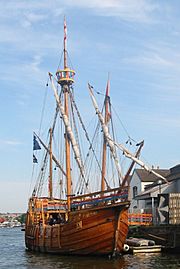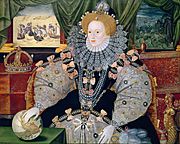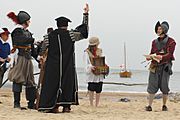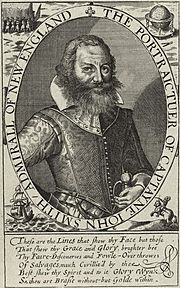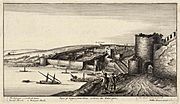English overseas possessions facts for kids
The English overseas possessions were lands and places far away that the Kingdom of England took control of, explored, or bought over many centuries. This happened before 1707, when England and Scotland joined to form Great Britain.
These English lands became the starting point for the huge British Empire. England's power at sea and in trade grew quickly, though it wasn't as strong as the Dutch Republic, Portugal, or Spain at first.
The first English settlements were in Ireland. After that, they started in North America, Bermuda, and the West Indies. They also set up trading posts, called "factories," in places like Bantam in the East Indies and Surat in India.
In 1639, England began building forts on the Indian coast, starting with Fort St George. In 1661, King Charles II married Catherine of Braganza. As part of her wedding gift, he received new lands that used to belong to Portugal. These included Tangier in North Africa and Bombay in India.
In North America, Newfoundland and Virginia were the first main areas where England settled. During the 1600s, many other places were settled. These included Maine, Plymouth, New Hampshire, Massachusetts Bay, Connecticut, Maryland, and Rhode Island. In 1664, England took New Netherland and New Sweden from the Dutch. These lands became New York, New Jersey, and parts of Delaware and Pennsylvania.
Contents
- How England Started Exploring Overseas
- England's First Overseas Settlements
- English Lands in the Americas
- English Lands in India and the East Indies
- English Lands in Africa
- English Lands in Europe
- Becoming the British Empire
- English Lands Still British Overseas Territories Today
- Timeline of Key Settlements
- See also
How England Started Exploring Overseas
England's history as a kingdom goes back to the year 927. For a long time, English kings also ruled large parts of France. This was because of their history with the Duchy of Normandy. By 1453, after many wars, England only held onto Calais in France, which they lost in 1558. The Channel Islands are the only parts of the old Duchy of Normandy that still belong to the English Crown today.
The first time England expanded overseas was in 1169. This was when the Norman invasion of Ireland began. Thousands of English and Welsh settlers moved to Ireland. For centuries, the English monarch claimed to rule Ireland. However, they mostly controlled only a small area called the Pale. Much of Ireland stayed free of English rule until the 1500s and 1600s.
In the 1500s, England began to set up new settlements in Ireland with Protestant English settlers. This was called the plantations. For example, King's County (now Offaly) and Queen's County (now Laois) were settled in 1556. English control of Ireland changed over time. Ireland finally became part of the United Kingdom of Great Britain and Ireland in 1801.
After Christopher Columbus sailed to the Americas in 1492, King Henry VII wanted England to explore too. In 1496, he sent John Cabot to find a new sea route to Asia. Cabot sailed in 1497 and landed in Newfoundland. He thought he had reached Asia. He didn't try to start a permanent settlement. He sailed again the next year but was never seen again.
The English Reformation made England and Spain enemies. In 1562, Queen Elizabeth I allowed English ships, called privateers, to attack Spanish ships. These privateers, like John Hawkins and Francis Drake, raided Spanish ports and ships carrying treasure from the Americas. Important writers like Richard Hakluyt and John Dee encouraged England to build its own empire overseas.
Spain was already strong in the Americas. Portugal had many trading posts in Africa, Brazil, and China. The French had started settling along the Saint Lawrence River in what became New France.
England's First Overseas Settlements
The first English settlements overseas began in 1556 with the plantations of Ireland. Many people who helped set up colonies in Ireland later played a part in settling North America. These included a group known as the "West Country men."
The first English colonies in America were started in the late 1500s, during the time of Queen Elizabeth I. The 1580s saw the first attempts to build permanent English settlements in North America. Soon, many English people wanted to move overseas. They were looking for new land, trade opportunities, or religious freedom. In the 1600s, most English people moving overseas went to the West Indies, not North America.
Early Claims and Explorations
In 1576, Martin Frobisher sailed from London to find the North West Passage. He landed on Baffin Island in Canada. This was where the first Church of England service in North America took place. Frobisher returned in 1577 and claimed the area for Queen Elizabeth. In 1578, he reached Greenland and claimed it for England too. He also tried to start a settlement on Baffin Island, but it didn't work out.
At the same time, between 1577 and 1580, Sir Francis Drake sailed all the way around the world. He claimed several islands for Queen Elizabeth, including "New Albion" on the coast of California. However, these claims didn't lead to permanent settlements.
In 1578, Queen Elizabeth gave Humphrey Gilbert permission to explore overseas. Gilbert sailed to the West Indies to try and start a colony in North America. But his trip was stopped before he crossed the Atlantic. In 1583, Gilbert sailed to Newfoundland. He officially claimed the harbor of St John's and the land around it for England. But he didn't leave any settlers behind. He died on his way back to England.
The First Permanent Settlements
On March 25, 1584, Queen Elizabeth I gave Sir Walter Raleigh permission to start a colony in North America. This area was named Virginia in her honor. Raleigh had seven years to set up a settlement. He and the Queen hoped to find riches and create a base for privateers to attack Spanish treasure ships. Raleigh never went to North America himself. He sent others to found the Roanoke Colony, which later became known as the "Lost Colony."
On December 31, 1600, Queen Elizabeth gave permission for the East India Company to trade in the East Indies. The Company soon set up its first trading post in Bantam, on the island of Java. They also started others, like Surat, on the coasts of what are now India and Bangladesh.
Most new English colonies in North America and the West Indies were "proprietary colonies." This meant individuals or companies were given royal permission to start and govern them. Examples include the Virginia Company, which founded Jamestown in 1607. Jamestown was the first successful English settlement overseas.
Bermuda, the oldest remaining British Overseas Territory today, was settled by England after a shipwreck in 1609. The town of St George's, founded in Bermuda in 1612, is the oldest English settlement in the New World that has been continuously lived in.
Between 1640 and 1660, most English people moving to the New World went to the West Indies. By 1650, there were 44,000 English people in the Caribbean. The biggest English settlement was on Barbados.
In 1660, King Charles II started the Royal African Company. This company mainly traded in enslaved people. In 1661, Charles married a Portuguese princess, Catherine of Braganza. As part of her wedding gift, he received the ports of Tangier in Africa and Bombay in India. Tangier was very expensive to keep and was given up in 1684.
After the English took Fort Amsterdam from the Dutch in 1664, England gained control of the Dutch colony of New Netherland, including New Amsterdam. This was made official in 1667. New Netherland was renamed the Province of New York. The English also took control of former New Sweden, which became part of Pennsylvania.
English Lands in the Americas
North America
- St John's, Newfoundland: Claimed in 1583. People lived there all year round by 1620.
- Roanoke Colony, North Carolina: First started in 1585 but abandoned. A second attempt in 1587 led to the "Lost Colony" where settlers disappeared.
- Jamestown, Virginia: Founded by the Virginia Company in 1607. It became a royal colony in 1624.
- Bermuda: Settled by accident in 1609 after a shipwreck. Made official in 1612. St George's is the oldest English town in the New World that has been continuously lived in.
- Popham Colony, Maine: Settled in 1607 but abandoned after about a year.
- Plymouth Colony: Founded in 1620. It joined with Massachusetts Bay Colony in 1691.
- Ferryland, Newfoundland: First settlers arrived in 1621.
- Province of Maine: Granted in 1622, later sold to Massachusetts Bay Colony.
- New Hampshire: Settled in 1623.
- Salem Colony: Settled in 1628, joined with Massachusetts Bay Colony in 1629.
- Massachusetts Bay Colony: Founded in 1629.
- Connecticut Colony: Founded in 1633.
- Maryland: Founded in 1634.
- Rhode Island and Providence Plantations: First settled in 1636.
- New Haven Colony: Founded in 1638, joined with Connecticut in 1665.
- Province of New York: Captured from the Dutch in 1664.
- Province of New Jersey: Also captured from the Dutch in 1664.
- Rupert's Land: Named after Prince Rupert of the Rhine. The Hudson's Bay Company was set up in 1670 to trade in this vast area around Hudson Bay.
- Pennsylvania: Founded in 1681 as an English colony.
- Delaware: Separated from Pennsylvania in 1704.
- Province of Carolina: Settled in 1653. It later became two separate colonies: North Carolina and South Carolina.
West Indies (Caribbean Islands)
- Barbados: An English ship visited in 1605, but it wasn't settled until 1625. It became a major English settlement.
- Saint Kitts: Settled by the English in 1623. The island changed hands between English and French control many times.
- Nevis: Settled in 1628.
- Montserrat: Settled in 1632.
- Antigua: Settled in 1632 by English colonists from Saint Kitts.
- The Bahamas: English settlers from Bermuda moved to Eleuthera in 1648.
- Anguilla: First settled by English colonists from St Kitts in 1650.
- Jamaica: This island, previously Spanish, was taken by the English in 1655.
- Barbuda: Colonized by the English in 1666.
- Cayman Islands: Visited by Sir Francis Drake in 1586. England gained control in 1670.
Central and South America
- Guiana: An attempt to start a colony in 1604 failed to find gold and lasted only two years.
- Mosquito Coast: The Providence Island Company controlled a small part of this area in the 1600s.
- Falkland Islands: Claimed for England in 1690 by John Strong, who was the first to land there.
English Lands in India and the East Indies
- Bantam: The East India Company set up a permanent trading post here in 1602 on the island of Java.
- Surat: East India Company traders settled here in 1608. It was the Company's first main headquarters until 1687.
- Machilipatnam: A trading post was set up here in India in 1611.
- Run: A spice island in the East Indies. England claimed it in 1616 but lost it to the Dutch.
- Fort St George, at Madras (Chennai): This was the first English fortress in India, built in 1639.
- Bombay: Became an English possession in 1661 as part of Catherine of Braganza's wedding gift to King Charles II. The East India Company leased it in 1668 and made it their headquarters in 1687.
- Bencoolen: A pepper-trading center on the island of Sumatra, set up in 1685.
- Calcutta: Settled by the East India Company in 1690.
English Lands in Africa
- The Gambia River: In 1588, English merchants gained trade rights here. In 1618, King James I gave a company permission to trade with the Gambia and the Gold Coast. The English took Fort Gambia from the Dutch in 1661. The island where the fort stood was renamed James Island. The Royal African Company later took over.
- English Tangier: This was another English land gained by King Charles II in 1661 as part of his wife's wedding gift. It was important for its location but very expensive to keep, so it was given up in 1684.
- Saint Helena: An island in the South Atlantic. The English East India Company settled it in 1659.
English Lands in Europe
- Duchy of Normandy: Normandy became linked to the English crown in 1066. Most of it was lost to France by 1204. The Channel Islands are the only part that remained English.
- Duchy of Aquitaine: This land in France became English through marriage in 1152. It was lost to France by 1453.
- Pale of Calais: Calais was captured by England in 1347. It was the only English land left in mainland Europe after 1453. France took it back in 1558.
- Dunkirk: English and French forces captured Dunkirk from Spain in 1658. It was given to England but sold back to France in 1662.
- Gibraltar: In 1704, an Anglo-Dutch fleet captured Gibraltar for England. It became England's first European overseas land since 1662. Gibraltar became a very important naval base and still belongs to Britain today.
Becoming the British Empire
In 1707, England and Scotland joined together to form a new country called Great Britain. The agreement stated that people from the new country could freely trade and travel to all the lands and settlements belonging to Great Britain. The English trading companies and colonies then became British colonies.
English Lands Still British Overseas Territories Today
North America and the West Indies
Africa
- The island of Saint Helena (part of Saint Helena, Ascension and Tristan da Cunha)
Europe
Timeline of Key Settlements
- 1607: Jamestown, Virginia
- 1609: Bermuda
- 1612: Surat, India
- 1620: East coast of Newfoundland (island) and Plymouth, Massachusetts
- 1625: Barbados and Saint Kitts, Caribbean
- 1628: Nevis
- 1632: Antigua and Montserrat, Caribbean
- 1639: Chennai (Madras), India
- 1648: The Bahamas
- 1650: Anguilla
- 1655: Jamaica and Cayman Islands, Caribbean
- 1661: Mumbai, India and Dog Island, Gambia
- 1664: New Netherland, North America (became New York)
- 1666: Barbuda
- 1670: Turks and Caicos Islands and Rupert's Land
- 1690: Kolkata (Calcutta), India
- 1704: Gibraltar
See also
- Angevin Empire
- First wave of European colonization
- Plantations of Ireland
- Scottish colonization of the Americas
- Thirteen Colonies


